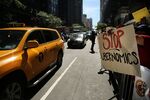VIDEO - Uber's New Pricing Idea Is Good Theory, Risky Business - Bloomberg
Economics
Charging well-heeled riders more is smart economics. Until they fight back.
byUpdated on

They really don't need more of this.
Photographer: Spencer Platt/Getty ImagesUber has finally confirmed what many people suspected: In some cities, at least, the company is not just raising fares when the demand for rides exceeds the supply of drivers, but is also charging higher prices to customers who it thinks will be willing to pay more.
The company uses the data it collects from customers to make educated guesses about price sensitivity. It might, for example, ask more from riders traveling to and from fancy neighborhoods, or from riders who regularly depart from businesses that are likely to provide expense accounts.


Uber Drivers Concerned About Upfront Pricing
That kind of personalized pricing – “price discrimination” in economese – is something of a holy grail because it allows companies to extract more revenue from consumers while simultaneously expanding the market. And Uber has an advantage in the race to perfect it: lots of fine-grained data on customer demand.
But Uber needs to be really careful. It’s not just studying economic theory – it’s operating a dynamic marketplace in the real world. And that means there are lots of ways that individualized pricing could backfire.
First, and perhaps most familiar for Uber, is the risk of a public-relations fiasco. That’s a danger for any company, but an especially significant one for a company already so troubled by bad publicity and internal culture problems that it just sidelined its chief executive, Travis Kalanick, who announced he'd be taking a leave of absence. 1
With price discrimination, though, Uber has been lucky so far: The online chatter about it hasn’t escalated into the kind of public anger that erupted over “surge pricing,” Uber’s other economically sound but notoriously unpopular pricing policy. Some of the commentary has even been positive, pointing out that while price discrimination can raise profits, it can also help society by enabling more people to access the market.
We applaud college financial aid policies, for example, because they expand access to education – but they’re a form of price discrimination, giving assistance to students who have less ability to pay, while charging full tuition to those with more resources. That said, it’s reasonable to doubt that improving access is really Uber’s goal.
If Uber’s new pricing just starts at today’s rates and pushes upwards, then Uber won’t bring in any new customers – it’ll just wring more out of the customers it already has. Moreover, at least at present, it’s not clear whether Uber’s drivers (who themselves often come from the lower end of the income-distribution range) will get a cut of the extra revenue. Taken together, those effects could put pressure on both riders and drivers – a formula that has caused public-relations headaches for Uber in the past.
That’s not all. Uber faces a formidable antagonist: its competitor Lyft. If Lyft doesn’t copy Uber’s price-discrimination strategy, ride-sharing customers will become more conditioned to compare prices. That would send Uber customers to Lyft until prices become competitive again.
And Uber’s customers may themselves be able to thwart Uber’s plans: Every time we open our apps, we give Uber a bit more data to feed its price-determining algorithms. That lets Uber know a lot about our willingness to pay, in the same way that Google knows which ads we’re more likely to click, and which YouTube videos we’ll watch over and over again. But unlike Google, Uber gets a relatively restricted snapshot of our behavior – it mostly just sees the locations we visit, which rides we consider, and which rides we do (or don’t) take.
As Uber starts price discriminating, we can try to trick its algorithms into believing that we have low willingness to pay. How? By injecting some false signals into the data stream. For example, we could open the app at random, check the prices on routes we sometimes take, and then close the app without calling for a ride – just to make ourselves look price-sensitive. We could further baffle Uber’s estimates of our ride preferences by considering (and sometimes taking) rides to unusual locations.
Uber’s market advantage and value proposition both rely on the company’s ability to estimate supply and demand. If Uber’s customers start trying to game the pricing algorithms, that could throw off Uber’s demand estimates, leading to uncertainty not only in pricing but also in availability – exactly what Uber’s surge pricing was set up to avoid.
The optimal response to these obstacles is unclear. To fend off the public relations hydra, Uber needs to increase the transparency of its pricing policies. But doing so could help consumers game the system and speed the exodus to Lyft. It’s a challenge, but King Uber will have to solve it on the quest for its pricing holy grail.
This column does not necessarily reflect the opinion of the editorial board or Bloomberg LP and its owners.
To contact the author of this story:
Scott Duke Kominers at kominers@fas.harvard.edu
To contact the editor responsible for this story:
Jonathan Landman at jlandman4@bloomberg.net
Scott Duke Kominers is the MBA Class of 1960 Associate Professor of Business Administration at Harvard Business School, and a faculty affiliate of the Harvard Department of Economics. Previously, he was a junior fellow at the Harvard Society of Fellows and the inaugural research scholar at the Becker Friedman Institute for Research in Economics at the University of Chicago.
Read more opinion Follow @skominers on Twitter